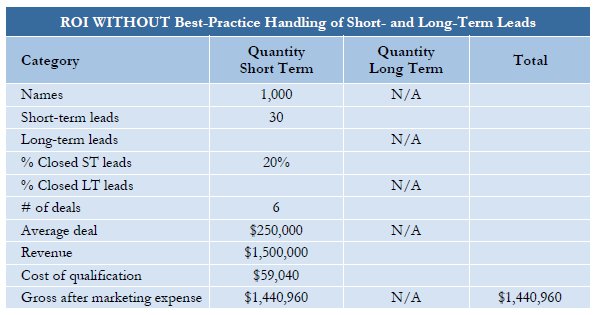
“Half of the marketing money you spend is wasted — trouble is you don’t know which half,” said William Lever of Lever Bros. in 1885.
With due respect to Mr. Lever, we know a significant portion of the wasted half is made up of opportunities qualified in an initial lead qualification initiative — but not followed up over the long term.
The good news is that we can reap the value of these long-term leads with best-practice lead nurturing processes. The end result: It’s possible to exponentially grow the return on the original program with only an incremental investment in handling long-term opportunities.
Here are two ROI models that compare results from a short-term-only approach to results from a combined short- and long-term approach. Note the first model ignores long-term opportunities.

The second model includes both the 40 long-term opportunities uncovered in the initial round of qualification and the moderate investment required to conduct long-term lead nurturing with this group.

Most marketing and sales executives would gladly spend US$4,920 to generate $1,995,080 in incremental revenue ($3,936,040 minus the $1,940,960).
And yet, as compelling as the business case is for nurturing long-term leads, many marketing and sales teams either do not implement this critical approach — or they attempt to do so without success. In fact, while 45 percent of qualified companies will purchase a solution within a year, sales does not follow up on more than 70 percent of leads provided to them.
It’s helpful to look at why this perfectly logical idea is so infrequently executed, much less well executed.
Wrong for the Job
Marketing groups are not the best fit for nurturing qualified long-term opportunities. With a focus on building brands, developing content, and executing programs to generate large numbers of inbound responses, marketing resources do not possess the lead management skills or the bandwidth to engage and nurture long-term leads.
I might add that because marketing is incented to deliver large volumes of leads at the lowest cost-per-lead, it winds up being faulted for generating too few leads of high quality or too many leads of low quality.
Sales does not follow up on many leads for both legitimate and nonintuitive reasons. The legitimate reasons for no followup are that the leads are obviously low end and unfiltered. They may be companies from the wrong verticals or too small to be in the market. Nonintuitive reasons include the “I called three times and didn’t get a call back.” Basically, if the lead is hard to work, it is often dismissed.
Management rightfully motivates and compensates salespeople to focus on closing short-term deals that drive quarterly results. To fully leverage the talents of your sales force, don’t expect sales representatives to cultivate long-term leads until they are qualified sales opportunities. They just won’t — and furthermore, shouldn’t — do it.
So if sales and marketing are not the right resources to follow up on companies that are qualified without immediate interest, who are the right resources?
Lead Farmers
Best practices suggest that a separate group, inside or outside the company, needs to take control of the vital long-term lead nurturing function. Think of this group of specialists as lead farmers — they qualify raw leads, nurture lukewarm prospects into the hot category, and turn the developed leads over to the sales force for harvesting.
A developed lead is one that sets the stage for relationship selling. A lead farmer equips the sales representative at the right time with in-depth knowledge about the prospect. With advance insight into the prospect’s motivations, pain points and buying plans, the sales rep can engage the prospect in a consultative conversation.
Often this process takes months. Over the course of a quarter, for example, you may have invested several dozen call attempts, as well as multiple emails and voicemails. A lot of people ask me if that is too many touches. They ask if we don’t frequently get calls from these targets saying, “Stop calling me!” In truth, professionally developed programs rarely result in that feedback.
If you are ignoring your long-term leads, you are wasting significant dollars, energy and other resources. Systematic nurturing of long-term opportunities is your best strategy for effectively increasing your marketing and sales productivity, closing more deals and driving more revenue.













































